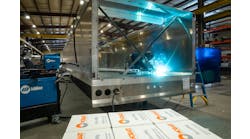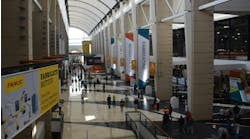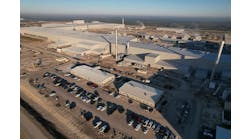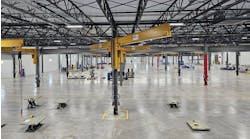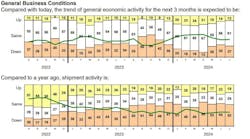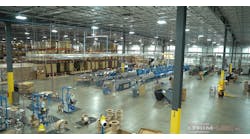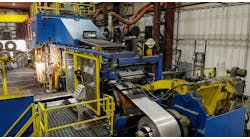Economic activity in the manufacturing sector grew in August, with the overall economy notching a fourth consecutive month of growth, say the nation's supply executives in the latest Manufacturing ISM Report On Business.
“The August PMI registered 56 percent, up 1.8 percentage points from the July reading of 54.2 percent,” Timothy R. Fiore, CPSM, C.P.M., and chair of the Institute for Supply Management Manufacturing Business Survey Committee. “This figure indicates expansion in the overall economy for the fourth month in a row after a contraction in April, which ended a period of 131 consecutive months of growth.”
According to the report:
- The New Orders Index registered 67.6 percent, an increase of 6.1 percentage points from the July reading of 61.5 percent.
- The Production Index registered 63.3 percent, up 1.2 percentage points compared to the July reading of 62.1 percent.
- The Backlog of Orders Index registered 54.6 percent, an increase of 2.8 percentage points compared to the July reading of 51.8 percent.
- The Employment Index registered 46.4 percent, an increase of 2.1 percentage points from the July reading of 44.3 percent.
- The Supplier Deliveries Index registered 58.2 percent, up 2.4 percentage points from the July figure of 55.8 percent.
- The Inventories Index registered 44.4 percent, 2.6 percentage points lower than the July reading of 47 percent.
- The Prices Index registered 59.5 percent, up 6.3 percentage points compared to the July reading of 53.2 percent.
- The New Export Orders Index registered 53.3 percent, an increase of 2.9 percentage points compared to the July reading of 50.4 percent.
- The Imports Index registered 55.6 percent, a 2.5-percentage point increase from the July reading of 53.1 percent.
“After the coronavirus (COVID-19) brought manufacturing activity to historic lows, the sector continued its recovery in August, the first full month of operations after supply chains restarted and adjustments were made for employees to return to work,” Fiore said. “Survey Committee members reported that their companies and suppliers operated in reconfigured factories, with limited labor application due to safety restrictions.”
Panel sentiment was “generally optimistic” (1.4 positive comments for every cautious comment), though to a lesser degree compared to July, Fiore noted.
Meanwhile, Demand expanded, with
- New Orders Index growing at very strong levels, supported by the New Export Orders Index expanding modestly;
- Customers’ Inventories Index at its lowest figure since June 2010, a level considered a positive for future production, and
- Backlog of Orders Index indicating growth for the second consecutive month.
Consumption (measured by the Production and Employment indexes) contributed positively (a combined 3.3-percentage point increase) to the PMI calculation, with industries continuing to expand output compared to July.
Inputs—expressed as supplier deliveries, inventories and imports—were flat during the survey period, due to supplier delivery issues returning and import levels expanding moderately. Inventory levels contracted again due to strong production output and supplier delivery difficulties. Inputs likely were the biggest impediment to production growth and contributed negatively (a combined 0.2-percentage point decrease) to the PMI calculation. (The Supplier Deliveries and Inventories indexes directly factor into the PMI; the Imports Index does not.) Prices continued to expand and at higher rates, reflecting a shift to seller pricing power — a positive for new-order growth.
Demand and consumption continued to drive expansion growth, with inputs representing near- and moderate-term supply chain difficulties, the report added. Among the six biggest manufacturing industries, Food, Beverage & Tobacco Products remains the best-performing sector, with Chemical Products; Computer & Electronic Products; and Fabricated Metal Products growing strongly. Transportation Equipment also expanded, but at a low rate. Petroleum & Coal Products sunk into contraction territory.
What respondents are saying
- “Current sales to domestic markets are substantially stronger than forecasted. We expected a recession, but it did not turn out that way. Retail and trade customer markets are very strong and driving shortages in raw material suppliers, increasing supplier orders.” (Fabricated Metal Products)
- “Rolling production forecasts are increasing each week compared to prior forecast.” (Primary Metals)
- “Business is very good. Production cannot keep up with demand. Some upstream supply chains are starting to have issues with raw material and/or transportation availability.” (Chemical Products)
- “Watching COVID-19 situations in Mexico, Brazil, Philippines [and] Hong Kong. High rates of COVID-19 surging. Currently, lines of supply no longer impacted by COVID-19 related events.” (Computer & Electronic Products)
- “Homebuilder business continues to be robust, with month-over-month gains continuing since May. Business remains favorable and will only be held back by supply issues across the entire industry.” (Wood Products)
- “We are seeing solid month-over-month order improvement in all manufacturing sectors such as electrical, auto and industrial goods. Looking to add a few factory operators.” (Plastics & Rubber Products)
- “Strong demand from existing and new customers for our products, stable-to-decreasing input costs for our operations, and record numbers of new business opportunities from prospective customers’ reshoring measures. All trends continuing from the first quarter of fiscal year 2017.” (Electrical Equipment, Appliances & Components)
- “Capital equipment new orders have slowed again. Quoting is active. Many customers waiting for the fourth quarter to make any commitments.” (Machinery)

